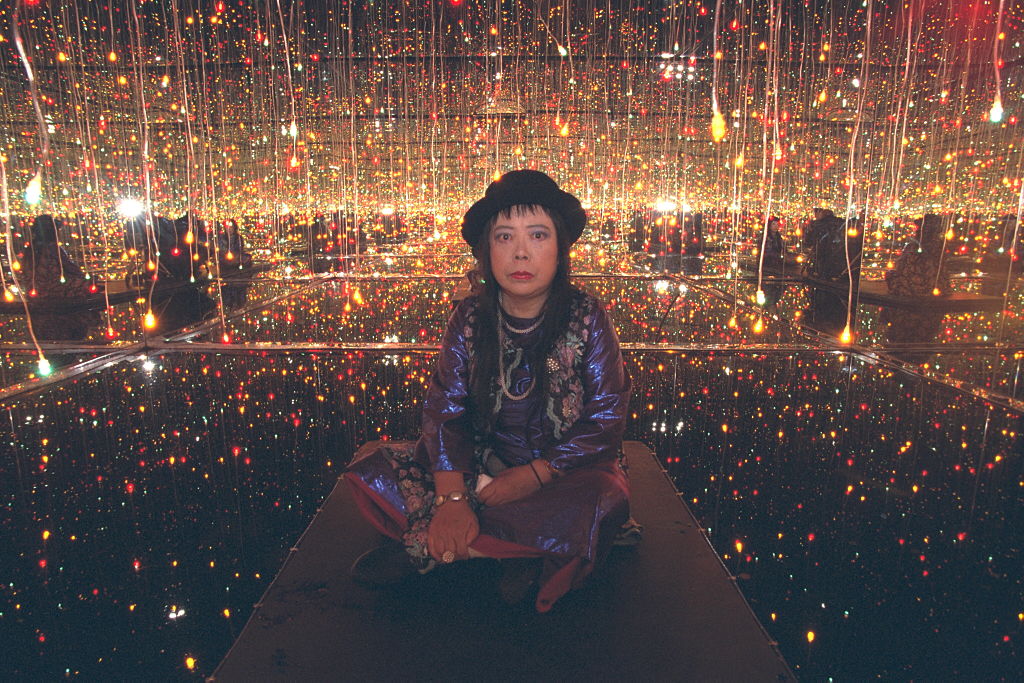
Before Yayoi Kusama became a world-famous contemporary artist and icon of avant-garde counterculture, she was a less than ordinary student studying traditional Japanese painting at Kyoto City University of Arts. Feeling alienated in her own country, she developed a keen interest in Abstract Expressionism. In what would prove to be a defining moment in her life, her interest in American art motivated her to write a letter to the artist Georgia O’Keeffe, telling her how much she admired her paintings.
Despite knowing neither O’Keeffe nor the English language, Kusama not only received a reply but, in her own words, was also given “the courage to take the leap of fate and move to New York.” After spending several months in poverty and loneliness, she was soon accepted by the Big Apple’s vibrant community of artists, becoming friends with people like Andy Warhol, Donald Judd, Eva Hesse, Claes Oldenburg, and, of course, O’Keeffe.
Yayoi Kusama with Joseph Cornell in New York (1970). Courtesy Yayoi Kusama Studio, Inc.
During her time in New York, she also befriended a lesser-known, more reclusive artist named Joseph Cornell. A self-taught pioneer of assemblage art who often worked with discarded artifacts, Cornell hardly ever left his family home in Queens, where he cared for his abusive mother and disabled brother. Kusama also grew up with an troubled mother—a commonality that no doubt contributed to their unlikely friendship.
The deeply romantic Cornell disliked selling his artworks, yet he frequently gave them to acquaintances as gifts—especially, as one art blog reports, to women. In addition to collages and assemblages with messages like “Have some tea and think of me,” Kusama, who was 26 years Cornell’s junior, also received a regular supply of letters and phone calls.
“He wrote me many times and called me many times every day,” she later recalled. “People would think my telephone was broken, and I would say, no, it’s only Joseph Cornell calling me so often.” Once, Cornell sent her 14 letters in a single day.
Although commentators have often described her relationship with Cornell as platonic, photographs show the two in loving embraces. Kusama reportedly spent many days at Cornell’s Queens home, where they would sketch each other in the nude. Cornell’s mother, who according to Kusama used to tell him that “women are a disease,” once poured water over the couple when she caught them kissing beneath a quince tree in the backyard.
“It was an ideal relationship for me,” Kusama has said. “I disliked sex and he was impotent so we suited each other very well.” Though she eventually distanced herself from Cornell, who apparently was becoming too clingy for her liking, they remained in touch until his death in 1972.
Cornell’s passing greatly impacted Kusama, who ended up moving back to Japan and checking herself into the Seiwa Hospital for the Mentally Ill, where she resides to this day. Having struggled with mental health issues and hallucinations since early childhood, the 95-year-old artist now leaves the facility only to visit her nearby studio.
“I fight pain, anxiety, and fear every day,” she confessed in a 2012 interview, “and the only method I have found that relieved my illness is to keep creating art. I followed the thread of art and somehow discovered a path that would allow me to live.”
What’s the deal with Leonardo’s harpsichord-viola? Why were Impressionists obsessed with the color purple? Art Bites brings you a surprising fact, lesser-known anecdote, or curious event from art history.